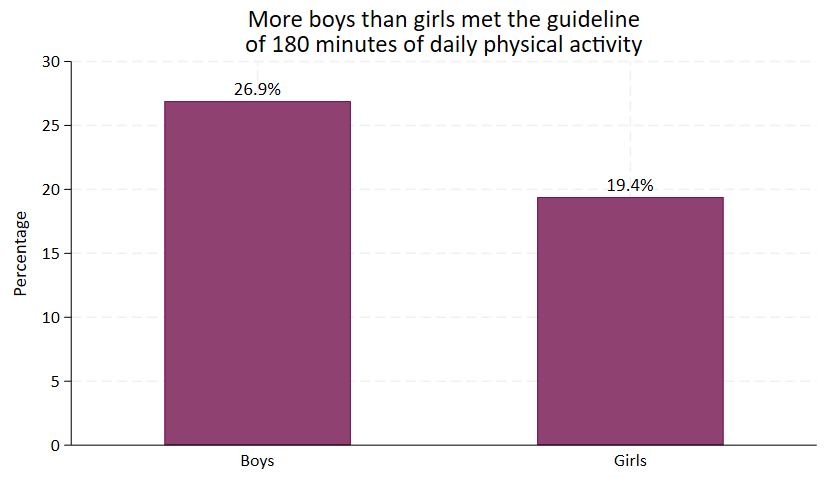Children are more active when in Early Years Settings than at home, but still not active enough
Physical activity levels peak around the age when children start school and tend to decline as children get older. Therefore, early years settings (EYS), like day nurseries, preschools and nursery schools, provide a critical role in establishing healthy habits in young children to encourage activity.
About the research
In England and Scotland, over 90% of children from age two access some form of early years education. The recent government expansion of funded hours will likely increase both the number of children and length of time spent within these settings.
The World Health Organisation (WHO) recommend that children aged under 5 years should engage in at least 180 minutes of physical activity each day, with 60 minutes spent in moderate to vigorous physical activity for 3-4 year olds. However, there is currently limited data on how active young children are in the UK, so it’s unclear what the health impact of expanded provision could be.
Our study included 419 boys and girls aged 2-4 years from four areas of England and Scotland -Ayrshire and Arran (Scotland), Sandwell, Somerset and Swindon (England). Accelerometers (devices like pedometers which measure activity quantity and quality) were worn for a week to capture physical activity when children were attending and not attending early years settings. We assessed the results against the WHO physical activity guidelines.
Policy recommendations
- Early years settings (EYS) play an important role in providing opportunities to be more active and reducing inequalities.
- Funding to support EYS in providing structured and unstructured activity opportunities should focus on sufficient staffing, and the provision of setting-specific equipment.
- Provide specific and practical guidance to EYS on encouraging children to be physically active, and ensure standards within the Early Years Statutory Framework support this through, e.g., outdoor space requirements.
- Investment should be expanded to support equitable physical activity including free flowing opportunities for children to move from indoor to outdoor spaces through open doors and with appropriate outdoor clothing.
- Early Years practitioners should be given practical training to encourage children’s participation in physical activities, and to discuss the importance of higher intensity movement with parent/carers.
- Adequate government funding is needed to ensure providers are able to match the government-funded hours provision with demand, so that all children have the opportunity to attend Early Years care and education settings – regardless of where they live.
Key findings
- Children were active for 15 minutes more, on average, on days when they attended early years settings, compared to weekends or non-nursery days.
- Overall, physical activity levels were low. Less than a quarter (23%) of preschoolers met the World Health Organisation (WHO) activity guidelines of 180 minutes of daily physical activity, and just 2.4% of 3-4-year-olds achieved the target of 60 minutes of moderate to vigorous physical activity.
- Boys were significantly more likely to meet these guidelines than girls (8% more boys met the 180 minutes target).
- Outside of early years settings, children from less deprived areas were more active than children from the most deprived areas. Whereas, when children were in early years settings, their activity levels were similar.


Further information
Maishman R et al. Accelerometer-Measured Physical Activity in UK Early Childhood Education and Care Settings: A Cross-Sectional Study, 24 Nov 2025, Journal of Physical Activity and Health https://doi.org/10.1123/jpah.2025-0316
NAPSACC UK study: https://napsaccuk.blogs.bristol.ac.uk/
Kipping R et al. Protocol to evaluate the effectiveness and cost-effectiveness of an environmental nutrition and physical activity intervention in nurseries (Nutrition and Physical Activity Self Assessment for Child Care – NAP SACC UK): a multicentre cluster randomised controlled trial. 2 Aug 2023, BMC Public Health. https://doi.org/10.1186/s12889-023-16229-y
Acknowledgements
The NAP SACC UK study was funded by the UK National Institute for Health and Care Research (NIHR) Public Health Research Programme (12/75/51). The views expressed are those of the authors and not necessarily those of the NHS, the NIHR, or the UK Department of Health.
The NAP SACC UK Trial which the data for this study are from was designed and delivered in collaboration with the universities of Birmingham, Glasgow and Cardiff as well as the Bristol Trials Centre (BTC), a UKCRC Registered Clinical Trials Unit which receives NIHR CTU Support Funding.
Authors
Dr Rachel Maishman, Prof Peter S. Blair, Prof Ruth Kipping, Prof Russell Jago, Dr Kim Hannam, University of Bristol
Dr Alex Dobell, Prof Miranda Pallan, University of Birmingham
Prof James White, University of Cardiff
Prof Sharon Anne Simpson, Dr Anne Martin, University of Glasgow
